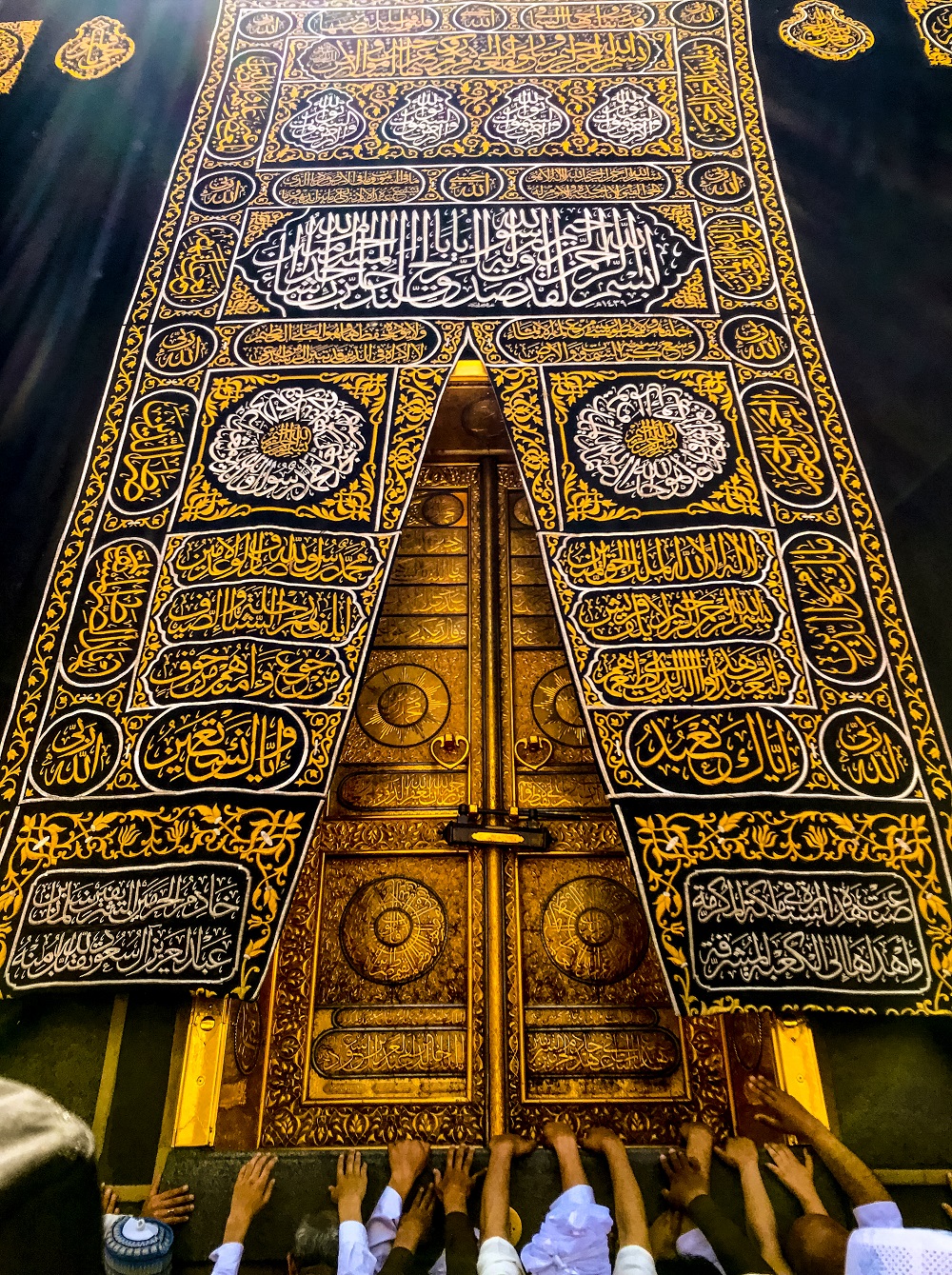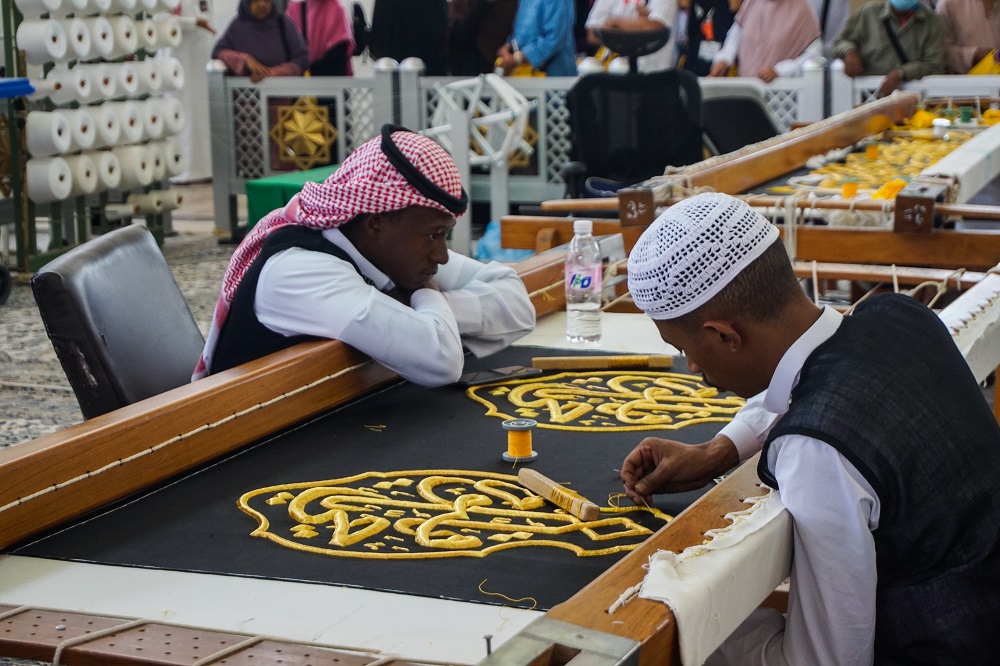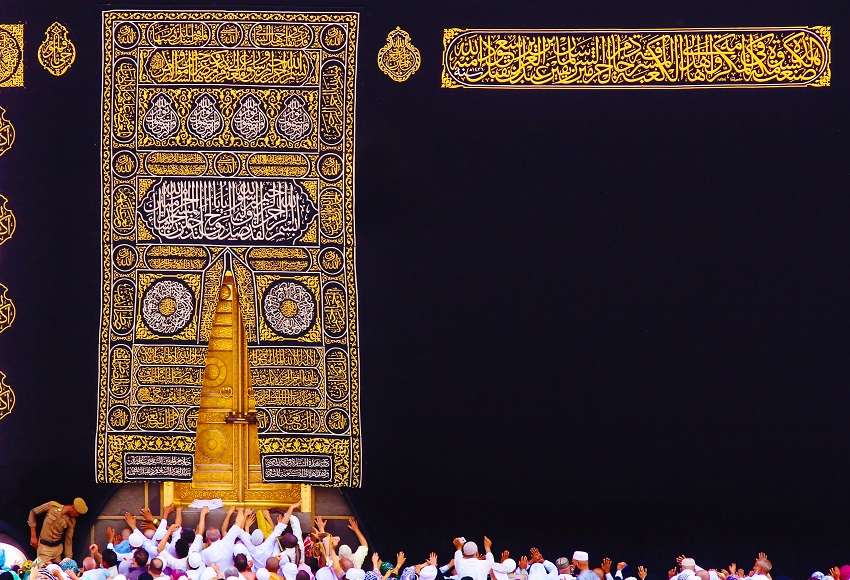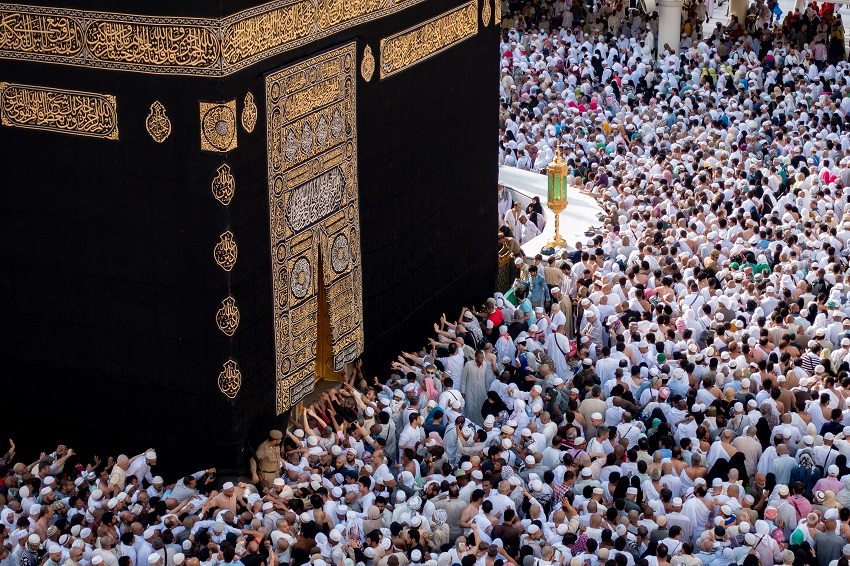Kiswa of Kaaba refers to the ornately embroidered piece of cloth that is used for covering the Kaaba, the centre of Masjid-al-Haram in Makkah, Saudi Arabia. In accordance with Islamic traditions, every year, the old Kiswa cloth is replaced with a new one on the ninth day of the month of Du al-Hijjah (the month of Hajj). This custom of annually draping the new cloth over the Kaaba is considered very significant in Islam. It is a testament to the faith and dedication of millions of Muslims.
Kiswa can be understood as the curtain or the piece of cloth that covers the most sacred shrine of Islamic people, the Holy Kaaba. In Arabic, this term means ‘pall’ that refers to the cloth draped over the casket. The Kiswa cloth is made from high-quality silk and features holy verses of the Quran weaved into its pattern with gold and silver threads. It covers an area of about 658 sqm and requires about 137 workers and eight months of hard work for its completion. The cover weighs about 670 kg and uses 15 kg of gold threads. Kiswa holds great significance in the Muslim culture and is symbolic of the reverence and divinity of Kaaba.
What Is The Relevance Of Kiswa Of Kaaba?
Kaaba is the centre of the Islamic world and is visited by multitudes of Muslims during the annual pilgrimage of Hajj. It has been demolished and rebuilt several times since its construction and is revered as a sacred place. Because of this high importance that is bestowed upon Kaaba, the Kiswa cloth that covers it is considered very significant. It is one of the most crucial aspects of the veneration of the holy Kaaba.
Every year, the lower part of Kaaba’s Kiswa, the black cloth draped around the holy shrine, is raised 3 meters in preparation for the new Hajj season and is replaced with white cloth instead. The procedure is done every year before the Hajj season in order to protect the Kiswa, as some pilgrims touch and pull on the black cloth when they do ‘Tawaaf’ of the Holy Kaaba. And, on the ninth day of the month of Dhu al-Hijjah, a new Kiswa is draped over the holy structure of Kaaba. It is believed that Kiswa glorifies and honours the place that is considered the most sacred in Islamic traditions.
What Happens To The Old Kiswa Cloth After Replacement?
In the earlier times, the new Kiswa cloth was simply put over the old one, but this practice was changed after some time. According to the present traditions, after the new Kiswa is draped over the Kaaba, the old one displaying holy verses from the Quran is removed and cut into pieces. Afterwards, these pieces are handed over to organisations and visiting Muslim dignitaries.
The History Of Kiswa Of Kaaba
The history of Kiswa since the time Kaaba was without it to the present point in time is long and complicated. Here are a few important incidents in the timeline of Kiswa of Kaaba’s history.
The Origin

Most Muslims believe that the Kaaba was without Kiswa until the reign of King Tubba Abu Karab Asad of the Himyarite Kingdom. King Tubba is believed to be the first person to drape the holy shrine of Kaaba. According to legends, after him, his successors treated covering Kaaba to be a religious duty.
Changes During The Reign Of Prophet Muhammad
It is believed that Prophet Muhammad and Muslims of Makkah did not indulge in draping Kaaba until 630AD as the Quraysh people did not allow them the honour. After the Muslims conquered Makkah, the replacement ceremony was not held until the day when a woman accidentally set fire to the Kiswa while performing prayers. After this incident, Prophet Muhammad covered the Kaaba with a cloth from Yemen.
Kiswa Under Other Rulers
During the reign of the Caliphs, the Kiswa ceremony was undertaken by the state. At this time, Egypt was popular for its art of weaving complex designs and was designated the responsibility of designing Kiswa.
After them, during the reign of the Ottoman empire, great care was taken into choosing the finest craftsmen from Egypt for weaving Kiswa. It was during this time that Kiswa was made from black silk. Since then, it became a practice to use black cloth for draping Kaaba.
In the year 160, Al-Mahdi Al-Abbasi decided to start the custom of layering Kaaba with a single-layer Kiswa following the removal of the old one. Until then, Kiswa was never removed from Kaaba, and a new one was simply put over the old one, time after time.
The Making of Kiswa

The Kiswa cloth holds high significance in the Islamic culture. Its making is very delicate and can be divided into five stages. Here is how it goes:
- Dyeing – In the first stage, the Kiswa cloth is soaked in hot water and left in a mix of soap, water, and other elements for a period of 24 hours. After the silk turns white, the cloth is then dyed in black, red, and green colours.
- Weaving – Earlier, the weaving of Kiswa cloth was only done by hand. But in the present times, the parts that do not require delicate artistry use mechanical weaving.
- Printing – In the third step of the process, the designs and the calligraphy that will be displayed on the Kiswa cloth are carefully printed.
- Embroidery – This is the most time-consuming and strenuous stage of the Kiswa making process, where the actual embroidery is carried out with utmost care and caution. All the calligraphy and designs are woven into the cloth using gold and silver threads, and the verses are filled with cotton stuffing at the embroidery stage.
- Preparation – This is the final step in the process, where the corners of Kiswa cloth are coordinated and located to display the designs and verses at their proper place.
Facts about Kiswa of Kaaba
- Each year, Kiswa of Kaaba is cut into smaller pieces and gifted to different dignitaries to honor their presence. Some of the pieces are also given to Hajj pilgrims.
- Kiswa of Kaaba contains around 47 cloth pieces stitched together to form a 658 mt length of cloth. A Kiswa can cost around SAR 17 Million depending upon the requirement of that year.
- The cloth of Kaaba comes from different countries such as Yemen, Iraq, Egypt and Baghdad.
- The date of changing the Kaaba’s Kiswa had changed from 10 Dhul Hijjah to 9th Dhul Hijjah at present.
This is how the holy Kiswa cloth is crafted every year. Kiswa of Kaaba is one of the most pious and breathtaking sights at masjid Al-Haram. The beautiful Islamic traditions lend it immense significance and make all processes related to its creation and replacement acts of religious importance. Its intricate motifs and calligraphy display excellent craftsmanship and leave all pilgrims in awe.
Suggested Read: History Of Kaaba: From Origin To Its Last Renovation In 1626
Kiswa of Kabba FAQs
What is Kiswa of Kaaba?
Kiswa of Kaaba is the heavily embroidered piece of fabric that is utilized for covering the Kaaba, the focal point of Masjid-al-Haram in Makkah.
What is the origin of Kiswa?
Most Muslims accept that the Kaaba was without Kiswa until the rule of King Tubba Abu Karab Asad of the Himyarite Kingdom. Lord Tubba is accepted to be the principal individual to wrap the sacred shrine of Kaaba. According to legends, after him, his successors treated covering Kaaba as a religious duty.
What happens to the old Kiswa cloth after replacement?
As per the current customs, after the new Kiswa is draped all over the Kaaba and the used one that displays sacred verses from the Quran is taken out and cut into pieces. Afterward, these pieces are handed over to some individuals, organizations, and visiting Muslim dignitaries.
How much does it cost to make Kiswa?
The Kiswa of Kaaba is made in around SAR 17 Million.









